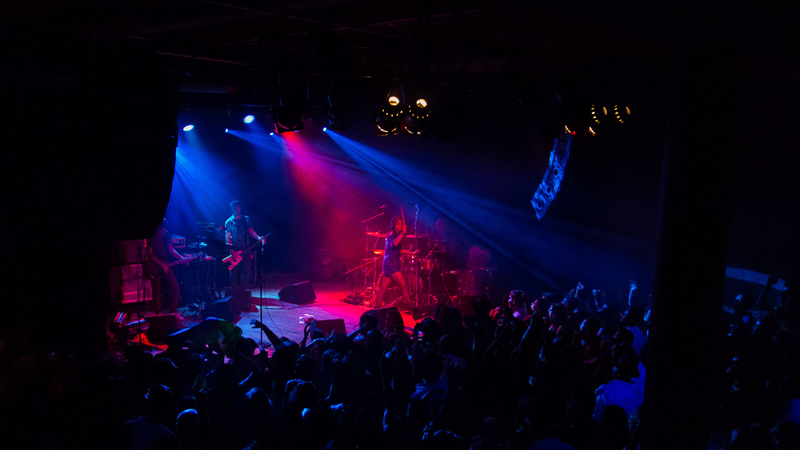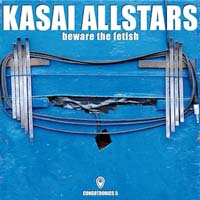
| KASAI ALLSTARS
BEWARE THE FETISH (Crammed Disc cram233)
Electrified likembe music is somewhat akin to the punk music of Africa: it's raw, ragged, emotional and has a real do-it-yourself aesthetic. But unlike punk it didn't arise in reaction to something else (say the smoother big band music of the Congolese bands like OK Jazz or Afrisa which could be compared to Rock, R&B and blues bands of the same era), because likembe music always existed as a folk form, a way of amusing oneself or getting together with friends. Years ago I found it in the OCORA series of folk music recordings from Africa which also included religious rituals and entrancing pygmy music. In 1978 OCORA (who are the field branch of Radio France) recorded four likembe bands in Kinshasa, among them Konono No 1 and Sankayi, one of the groups featured on this disc. Like me, Crammed Disc's A&R man, Vincent Kenis was captivated by these groups and he launched the Congotronics series of recordings of which this is the fifth installment. Congotronics 2: Buzz 'n Rumble from the Urb'n Jungle also has a DVD of these bands in performance that is spectacular. Beware the Fetish is the sequel to Kasai's In the 7th Moon from 2008. Kasai Allstars is a collective of five different bands, all from the Kasai region of DRC, but from five different ethnic groups. Many of these groups fought in the past but one thing they have in common is that their music, as played in the bush, was regularly banned because of erotic lyric content and because the trance rituals they enacted were considered "pagan" by the authorities. So they decided to unite. There is a lot of diversity on here: not just different electric likembe players, but slit & buzz drums, xylophones and electric guitars all come into play. Also it's a double disc so it's real value for money, since, I, for one, could listen to this all day. The final cut is Congotronics vs Rockers to show the influence this music has had on Western bands: on it we hear Juana Molina joining in on vocals and half a dozen Western rockers jumping in on guitars and drums. Most of the two hours, however, is devoted to songs about hardships, evil leopards, enthronement rituals and parables, such as "As they walked into the forest on Sunday, they encountered apes dressed as humans," or "The one who sets fire to the bush catches nothing, while those who are on the lookout catch game." One song has the intriguing lyric: "Mbuyamba will now dance with one side of his body, as if the dance had only been borrowed." Though these Kasai people have moved to the city for various reasons, they are keeping their traditional music vital, absorbing outside influences rather than being swayed by them.
|

|
DJESSOU MORY KANTE
RIVER STRINGS - MANINKA GUITAR (Stern's STCD1124)
When you have one of those "who are the greatest guitarists" conversations with your music buddies you are often surprised by how many names from West Africa crop up, not just in the context of Franco and Nico, but in global big leagues with James Hendrix, Jeffrey Beck, Francisco Gomes (aka Paco de Lucia) and John McLaughlin. Now to the list of Djelimady Tounkara, Mama Sissoko, Sekou Diabaté, Lobi Traoré and Barthelemy Attisso, we need to add Djessou Mory Kanté. He's not the Mory Kanté of Rail Band who went to Paris and hit big with "Yéké yéké," but in fact the younger brother of Les Ambassadeurs' guitarist Kanté Manfila. That bona fide legend Djelimady Tounkara shows up to trade licks on two cuts, but Djessou is in control and has opted not to have singers on here (he has backed both Salif Keita and Sékouba Bambino on recent hit albums) but goes instead for a more laid-back instrumental set that showcases the musicianship of a group that embrace the traditional sounds of Mali and Guinea. It's the best traditional West African album in ages and reminds me in places of the incredible Hank Jones meets Cheick Tidiane Seck and the Mandinkas album Sarala, on which his big brother appeared. There is organ on here as well as balafon (which is not credited, so may be sampled on the keyboards?), and also fine jazzy bass (Kerfala Kanté) and a top notch kamala ngoni, played by Harouna Samaké. Small details, such as the ending of "Djandjo," show how well recorded it is: as the track fades we are left with the djembe player and the balafon trading licks and you immediately want to turn it up to catch the dying glow of their little exchange. It's been too long since his earlier release, Guitar Sèche on Popular African Music from 1998. This Sterns release will certainly jump-start his career. |

|
ADNAN JOUBRAN
BORDERS BEHIND (World Village 479084)
I recently got a promo or rather a download link to an intangible set that featured Trio Joubran, backing an Arab artist (actually a Belgian via Jordan) who shall remain nameless. Since I really liked their earlier CDs I was keen to hear it, but sadly it turned out to be rubbish, pure and simple. Why mess with a winning formula? The audience doesn't tire, it expands (maybe stretches a bit, but doesn't yawn). So I was pleased to get a new disc solely by Adnan, one of the Joubrans, and am glad to report it is spot on. There is a clarity to this, a sharpness, a real acuity as if they are listening as much as playing. When I say "they," I should point out there is only one of the Joubran brothers on here, Adnan on oud (also on percussion and voice), and a line up that includes tablas, cello and cajon, with a guest appearance from Jorge Pardo, renowned Spanish jazz/flamenco accompanist, on sax and flute (on four tracks). The mixture of Spain and Arabia is a natural one: Pardo has played with the al-Andalusian Ensemble as well as the recently deceased Paco de Lucia, and you sense Adnan is keen to show he can riff with the best of them on this outing. The title at first glance suggests Joubran's native Palestine, but then you think of the musical borders he has crossed to perform with Indians and Spaniards, but ultimately the borders are metaphysical ones, between what's been accomplished and what can be imagined. Lovely, lovely, lovely.
|
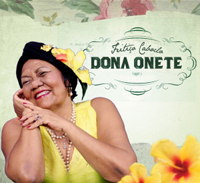
|
DONA ONETE
FEITICO CABLOCO (Mais Um Discos)
I've been hoping for something Brasilian to come along in time for the World Cup. Four years ago Shakira's remake of Zangalewa's hit "Waka Waka" filled the bill for the South African tournament, and while this is not raucous stamping-out-grassfires samba, it's perfect to get you mildly shimmying. One reason for the mellow restraint is that this is Dona Onete's debut disc, and she is 73. She comes from Pará in the Northeast of Brasil and this album reflects a lifetime of absorption in the sounds of her home. So there is African and European grafted onto the native rhythms as well as noticeable Caribbean pulses in a track like "Jamburana." This has a creeping horn section and a wicked wormy beat like the carousel ride of konpas. Onete began singing at age 11 in unusual circumstances. She was washing clothes on the river bank when she spotted a dolphin. She decided to sing to the dolphin to attract its attention. Next day there were more dolphins and soon she had a regular aquatic audience for her vocalizations. When she grew up she became a professor of History and Amazonian Studies and established folk troupes as part of her curriculum. She established a new musical form, carimbó chamegado, based on traditional rhythms and began composing songs but mainly sang for her own amusement or in bars when pressed to perform. But then some young guys who had a band called Coletivo Radio Cipó heard her sing and wanted her for their band: they had no idea she was an elderly lady. It's melodic and well arranged and a great debut.
|
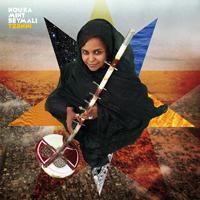
|
NOURA MINT SEYMALI
TZENNI (Glitterbeat GBCD/LP 016)
If you put this on the sound system at a blues bar they'd think it was the most down and dirty thing they'd heard. If the bar was in Mauretania (an ancient Berber kingdom that spans the Atlas mountains of southern Morocco and stretches into Algeria), they'd probably recognize the singer as the famous step-daughter of the legendary Dimi Mint Abba, or if they were older, grand-daughter of the also-legendary Mounina. Seymali's father is also a renowned musician, having composed the national anthem as well as creating a notation system for Moorish melodies. Noura's husband is the guitarist Jeiche Ould Chighaly and he is the driving wheel of this music, accompanied by another stringed instrument the harp-like ardine, played by his wife. Chighaly also plays tidinit which is the Mauretanian equivalent of the ngoni. Other than that, electric bass and trap drums complete the power line up. The title means "to spin" and you can imagine a dervish whirlwind stirred up in the tents of Nouakchott once this music kicks in. When you spin you lose control of your senses and become off balance: the music centers you and keeps you turning and your faith in the music holds you up as your senses give in to the power of the tune. Many of the songs are from the traditional repertoire: a lover who thought he was doomed to wander forever finds stability in the love of a woman; a praise song for the prophet Mohammed on his return to Medina after a victory in battle. The recording is clean, even when the vocals are on reverb, and the guitar on full effects pedals, you can still hear the tick of the drumsticks, played by Dakar-based producer Matthew Tinari. He says the drum rhythms are often inspired by traditional patterns played on plates or hand drums, for example, by guests at weddings. So the sound is a collaboration based on many folkloric elements but then updated with the rock and funk ideas of the musicians. While obviously influenced by her mother (Seymali started out as a backing singer), she also credits Oum Kalthoum, cheb Khaled, and even Etta James as inspirations. Her husband's listening includes Mark Knopfler and Hendrix as well as Albert King and Magic Sam. |
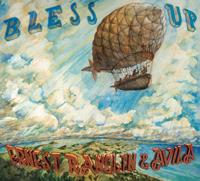
| ERNEST RANGLIN & AVILA
BLESS UP (Avilastreetrecords.com)
There's not a lot of info on this CD, apart from song titles. From those we figure that Ernie or his crew have been listening to Abdullah Ibrahim, since they start out with "Bra Joe from Kilimanjaro." There's also a cover of Ibrahim's "Blues for a Hip King" (though less successful), so I suspect the keyboard player Jonathan Korty (or is it Eric Levy?) has been practicing his big walking left hand for some time. On the title cut the sax player (Michael Pelloquin) steps up, so you don't really notice that it is a guitar album. In fact it is a mellow jazz-inflected album, and Ranglin is just a member of the band which, considering his advanced age, is a nice way to hear him rather than the pressure that would result if you expected all guitar all the time. He comes out riffing on track 6, "Joan's Pen," and shows he has not slowed down. Overall the feel is of a very accomplished Jamaican jazz session, but better recorded! Musically too it recalls the pre-Skatalites era, back when the Alpha Boys School grads were a jazz group recording Jazz Jamaica from the Workshop. That album was an early release of Studio One records (August 1962, issued especially for Independence) and featured young Ernie Ranglin "regarded as the most exciting player outside the United States today," according to Sonny Bradshaw. Since then Ranglin went on to appear on countless Jamaican music dates (including Millie Small's "My Boy Lollipop" which exploded Ska onto the British scene in 1964, sessions for Bob Marley, Jimmy Cliff, the Maytals, etc), and more recently a notable tour and album (In Search of the Lost Riddim) with Senegalese star Baaba Maal. This is not a repeat of Below the Bassline, his triumphant 1996 return, because that was based on some well-known Jamaican tunes ("Satta," "54-46" and his instrumental hit "Surfin") and featured legendary sidemen, including Monty Alexander on piano and Roland Alphonso on sax. That summit of giants is a landmark album. This is him in a relatively new setting. I am always wary of pickup bands, because I have suffered through plenty of reggae shows where a headliner just came to town alone and called the tunes while a bunch of local kids thought they could skank it in de bock yaad. But Ranglin has nevertheless put together a creditable band here, with tough horns and the requisite thudding bass (Yossi Fine, producer of Hassan Hakmoun) and (uncredited) Sly-Style drums. There's a tango! "El Mescalero," with harmonica, muted trumpet, Hammond B3 and some dribbling runs on guitar. Yes Ernie, the high octane octogenarian, is still tip top.
|
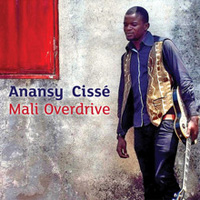
|
ANANSY CISSE
MALI OVERDRIVE (Riverboat Records TUGCD 1079)
Are you tired of "desert blues" yet? Well here's a fresh disc that will make your ears perk up. Originally based in Diré in Northern Mali, Anansy Cissé wrote songs and gave them to others to perform, being happy to engineer and record them. But Cissé had to dismantle his home studio and move south to Bamako, the capital, when the rampaging fundamentalists showed up across the desert after the fall of Libya (and you know which part of the anatomy is the fundament, right?). There he met Philippe Sanmiguel who persuaded him to record some of his compositions himself, so Cissé called in his friends to accompany him on ngoni and calabash. He was also able to get Zoumana Tereta, the master of the plaintive horsehair fiddle, or soku, to add his talents to the session. While his main inspiration is traditional music of the Fulani and Songhai peoples, Cissé is also an avid listener to the Stones, Pink Floyd, Led Zep and Crosby, Stills, Nash and Young, so that modernity and traditions collide in his music. It's really wonderful to hear his effects-laden electric guitar soaring over the ancient voices of slapped calabash, bass and riffing ngonis (there are two on here). Lacking anything else compelling in my new CD pile I have been playing it several times a day. Fans of the late Ali Farka Touré, who wonder where Malian music could go, will be heartened by this departure. There are no tricks, but Cissé has sampled a speech by Nelson Mandela to add some English-language context for his non-Malian listeners.
|
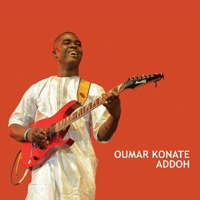
|
West African electric guitar. Killer grooves. Solid guest line-up. I know, I know, I've said this before but countries undergoing strife and tribulation produce the best music, and Mali is really on fire right now, both in terms of book burnings and crazy wild guitar bands cutting out of the desert and finding the cool of a recording studio (in this case in New York) to release their pent-up rage and energy. Oumar Konaté is a young virtuoso who has broken out from Khaira Arby's band to take the world by storm. As a teen he joined the National Orchestra of Gao, from where he went on to the National Institute of Arts in Bamako, before playing behind such luminaries as Vieux and Sidi Touré. His international debut is solid and rocking. Professor Louie (from Woodstock, who has backed various members of The Band) cranks up the Hammond B-3 to good effect and there's a smoky lead guitar on "Bismillah (Welcome)" followed by a track that sounds a lot like Ali Farka, with bright metallic lead on Ibanez (a Stratocaster copy?) that includes Zoumana Tereta, longtime sideman on all the best Malian sessions, on "traditional violin" which is of course his one-string horsetail soku fiddle, sawing away on "Ir ganda hassara (Our country is destroyed)" which runs the litany of places -- Gao, Kidal, Timbuktu -- that have been Zerstört by the Fukwit Brotherhood of Islam. "Laissez nous tranquille (leave us alone)" relies a little too much on effects pedals: they ALL seem to be on. I envision Konaté with one foot up on a Marshall amp, posturing in the Rock God stance, then a mirror pivots in and we see countless versions of him receding to infinity, all posing in silhouette. Yes, Clapton never did this, but I don't think he multitracked this much either. Konaté is a bit more selective on the next two tracks which put his voice to the fore. "Ma cherie (Baby don't do me wrong)" is not only a good blues but has a convincing but restrained Muscle Shoals horn section (courtesy of the Ethio-American Debo Band) wringing the harmony. But then "Allahidou (The Oath)" is also over-the-top: again he goes for the "stadium rock" setting and starts at blazing outtro pace. On the other hand when he picks acoustically, as on "Haira (Respect your parents)" you can tell he knows his chops, so though this album tries on many styles musically it's well worth a listen.
|
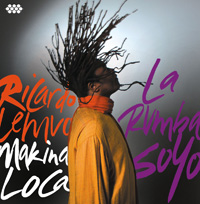
| RICARDO LEMVO & MAKINA LOCA
LA RUMBA SOY YO (Cumbancha CD31)
Here's another well-crafted set of danceable music from Ricardo Lemvo & his crazy kinsmen. It's their first new album in 7 years and shows why they are an in-demand live band with international appeal. Like Sam Mangwana, Lemvo is of Angolan parentage and he too grew up in Congo. His music is also classic Congolese -- rumba and soukous -- and on this album he also explores zouk, merengue and some Angolan styles, like semba and kizombo, to great effect. However, unlike old-time Congolese rumba which approximated Cuban music, Makina Loca actually gets deep in the pocket on son montuno ("Kari Kuyété") and salsa tracks, thanks in part to pianist "Baby Jesus" Perez. As a bonus there's real Latinos playing the Latin horn parts! The other secret weapon in Makina Loca's arsenal is guitarist Nseka Huit Kilos who started out in Orchestre Macchi with Dindo Yogo (later of Viva la Musica) and Lovy Longomba, then for years fronted Rochereau's l'Afrisa International until an American tour left him, fortuitously, in Los Angeles. His sweet licks and bell-tones ring throughout. There's even the intermittent accordeon. The mood is uptempo and effervescent until the bolero half an hour in which slows the pace nicely and we hear moody solos on guitar and muted trumpet (Arturo Solar). But there's barely time to cool down before we launch into a wild salsa whirl on "El Caburnacho." There are a couple of cover songs on here, which Lemvo has made his own, and he reprises "Samba Luku Samba" because it has evolved in performance into a stronger number than the take on Ay Valeria! Makina Loca are not only dependable, they go from strength to strength.
|
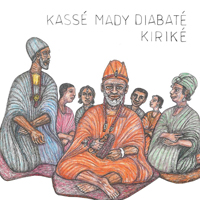
| KASSE MADY DIABATE
KIRIKE (No Format! NOF26)
(NB: US release date is January 6th on 6 Degrees)
There was a time when I mainly listened to Congolese music (so much in fact my girlfriend thought of starting a Soukous Widows' Society), then Cuban music took hold and it seems lately the best stuff coming out as new music is Malian. Yes Guinea, Senegal, Colombia still get time on the turntable, with Jamaica, Ghana, Cabo Verde and India close to hand, but in terms of stuff coming in over the transom I find the Malians consistently good: their musicians are top flight, their singers and songs engaging, and their rhythms put me in a happy frame of mind. Kassé Mady is one of the older griots from a distinguished family. His voice reminds me of Salif Keita's at times. He has appeared with fusion groups as well as Afrocubism and the Symmetric Orchestra of kora player Toumani Diabaté. The ensemble here is more stripped down and there's no acoustic or electric guitars: just balafon, ngoni and kora (Ballaké Sissoko on two tracks, early and late in the set as a bracketing device), while producer Vincent Segal (who also appears on Ballaké Sissoko's At Peace) plays cello to give us a resonant bass line. Makan Tounkara is featured on ngoni (his own album of traditional music appeared from Buda and, like Ballaké Sissoko's, garnered a most favorable review here). Lansiné Kouyaté has also backed Toumani Diabaté and he appeared on Kassé Mady's Kela Tradition album, which Stern's issued in 1990. He is elegantly understated here, playing what seems at times to be a muted balafon, behind Tounkara's ngoni solos. These guys have grown up together since their youth in the National Instrumental Ensemble of Mali and have mellowed in unison. They no longer need Taj Mahal to raise their profile (that album with Taj Mahal was cited by President Obama as one of his favorites), and give us a delightful hour of chamber music from the soul of Africa. |
MUZIKIFAN 2014 REISSUES OF THE YEAR
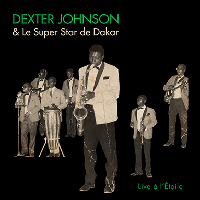
|
DEXTER JOHNSON & LE SUPER STAR DE DAKAR
LIVE A L'ETOILE (Teranga Beat)
Teranga set out to bring us great unknown & obscure Senegalese music and quickly moved to the realms of the fantastic: issuing CDs of brilliant, previously unreleased Senegalese music. Clean, clear and an hour and 17 minutes long, this concert showcases the brilliant tenor saxophonist who fronted L'Etoile de Dakar, the mother of all groups that gave rise to so many of the popular bands from Senegal in the 1970s and 80s. Johnson toots his tenor alongside three singers, John Gomis and William and Maīssa Ngom who replaced the departed Laba Sosseh. The repertoire is Afro-Cuban, so there are chestnuts -- "Coco Mai Mai," pops up as the chorus in "Para que bueno"-- we get "Mayeya (no juege con los Santos)" and "Soy hijo del Siboney," sandwiched around "Something you got" -- a wicked Wilson Pickett rave-up. There's no piano or trumpet and a much more laid-back approach to clave than you find in any Cuban music. The band is relaxed, the guitarists having a good time, Dexter chomping at the mouthpiece waiting to get back on top of the mike with a hot solo. He threatens to leave the singers behind with his flights of fancy, but the coro gives as good as it gets. It's a very well run show, though you get the feeling the recording is picking up mainly the vocal mikes so the two guitars are in the back of the room, but that's not a problem since the reverse is usually the case. Here you can hear the guiro, timbales and congas clearly and there's a fair bit of echo on the other instruments suggesting their sound is coming from amps, bouncing off the walls and then coming through the vocal mikes. This show was recorded in 1969 on the eve of the band's departure for a tour to Abidjan, Ivory Coast (hot on the trail of Laba Sosseh who had taken some of the band and gone to Abidjan ahead of them), so they are certain of their chops, even throwing down a couple of boogaloos among the guaguancos. Dexter was born in Nigeria and had traveled and played in many countries before joining the first Star Band in Senegal in 1957. His playing is grounded in Hi-Life and closer to lyrical American jazz than to the brusque honking of Manu Dibango -- you can also hear how he influenced Issa Cissokho of Orchestre Baobab, in fact you will hear how the Baobab sound comes directly out of this Star Band sound. He is a powerful presence on these recordings, with a reformed group featuring three singers vying to replace Laba, and some hot young percussionists taking up the challenge also. Confidently commanding all is Dexter weaving that old black magic.
|
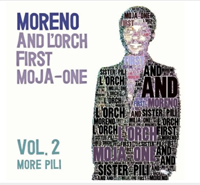
| MORENO & L'ORCH FIRST MOJA-ONE
VOL TWO: MORE PILI (AIT Digital/Stern's -- digital only)
Moreno has a voice that puts him in the ranks of Sam Cooke, Marvin Gaye, Greg Isaacs, Solomon Burke and Al Green, so it is a delight to have more Moreno. I have had some of these tracks for a long time, and listen to them frequently, but it is a treat to hear them restored from the original tapes and cleaned up by the tireless Doug Paterson. On one of his trips to Kenya, Doug secured the master tapes from A.I.T. and there is a picture of the box on his own website. The heavily doodled box shows that the tape contains four songs which were recorded on 14 December 1981. Two of the tracks were issued as singles and two were unreleased until now (not that they are any less great than those that came out: in fact "Sisili" is smoking hot). Paterson recalls hearing Moreno in Nairobi and being blown away by his deep, explosive voice: "With its precise intonation, an all-enveloping rich bass and a timbre which could suggest a distressed psyche, it was an unusual sound for a lead vocalist in East Africa." Indeed Moreno is unique and unmistakable and you can hear him singing with Bana Ngenge or Les Noirs, not to mention Shika Shika, Virunga, and IOSS. When I saw Virunga in Nairobi I thought he was the lead singer. The cuts assembled here are earlier than the tracks "Adidja" and "Danger Girl" from volume one which you doubtless own. They were originally on the one LP issued by L'Orchestre Moja-One. Another unique aspect of Moreno was his fidelity to his girlfriend, Pili, a Tanzanian model. He sang about her in "Sister Pili" and here celebrates her again in "Pili Mungwana." One of his monster hits, "Dunia ni Duara," is included. One line in it puzzles me: "Attaquez les Americano!" but then I don't know what it's about and sadly there are no liner notes in this etherial issue. Moreno also mentions "San Francisco" so perhaps he was being dashed by tourists. "Mariana," another of the unreleased tracks -- a ballad -- is sung in English & Kiswahili and has electric piano. It kicks up a notch at the seben. We have a rough idea who is on here: there are shout-outs to the hard-working drummer Lava Machine, but you might be misled by the calls to Jacomo (that's Felix the producer). But fortunately the professor, Siama Matuzungidi, is still with us so I asked him if he remembered the line-up. He replied that he thought Sammy Mansita played lead on two songs and provided names of all the musicians who were assembled in High Fidelity Studios in Nairobi for the session: "Moreno Batamba (singer, composer of all songs), Coco Zigo (singer), Dago Mayombe (singer), Gina Monganza (singer), Jacques Akomo (lead guitar), Mokili (lead guitar), Roy (lead guitar), Siama Matuzungidi, given name Rivancliff (rhythm guitar), Joniko Walengo (bass), Tommy Lomboto (bass), Lava Machine (drums), Caster (drum), Papa Joe (keyboard)." In "Sisili" (different from the Shika Shika song of the same name), Moreno names the singers, as well as a shout-out to Lava. "Sitaki Mambo" is unusual because it has a reggae beat, an inverted version of "Stir it up." Though not recorded in this session, it is another rarity unearthed by Paterson for inclusion here. Believe me there is more of this quality waiting to be reissued, so the bottom line, readers: You need to buy this so we get volume three!
|
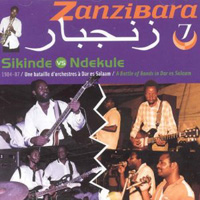
| ZANZIBARA 7
SIKINDE VS NDEKULE (Buda Musique)
It seems the odd numbers in this series are the ones to get for fans of "Muziki wa dansi," which was the widely popular music of East Africa in the 1970s and 80s. The even numbers are traditional Taarab music, but vols 3 and 5 have been brilliant compilations of rare, often never before heard, and beautifully restored classics that lit up the East Coast of Africa from Radio Tanzania and clubs from Malindi south to the verges of the Okovangu swamp. There is one small disappointment about this new release and that is four of the eleven tracks have appeared before on two compilations that I know any serious collector of African music has on their shelf: Tanzania Dance Bands vols 1 & 2, which came out from Monsun Records of Germany in 1989 and 1991. Actually volume two of that pair had some technical problems and was reissued with a revised tracklist from Africassette in 1995 (they dropped two and added three songs). This disc pitches International Orchestra Safari Sound [IOSS] against Mlimani Park in a friendly duel, with half a dozen tracks from each band. (The apparent rivalry was fomented by the singers and guitarists moving between the two bands.) The album kicks off with Mlimani's "Mtoto Akililia Wemba" which was on Dance Bands Vol 1. It's inclusion here is didactic as well as for the obvious reason it is fabulous; it also tells of the rivalry between these two bands. Their catchy song "Neema (My blessing)" was also on that earlier Monsun disc. The two IOSS tracks that are repeated are "Chatu Mkali" and "Homa Imenizidia." The latter was the song that provoked Mlimani's "Mtoto Akililia Wemba." The repeats come in the middle of the album as a solid core to remind you how brilliant this music can be or convince you if you don't have the Tanzania Dance Bands CDs. Still, three new songs from them is a welcome addition from a great band whose only known issue to me is two tracks on a vinyl album called Tanzania Hit Parade '88, issued by Ahadi Records of Nairobi. Then there are the cassettes: There were a dozen FLATIM cassettes issued of Mlimani Park, but only 4 I know of by IOSS (The songs here mostly come from the Christina Moshi cassette [MSK/CAS505]). The advantage of cassettes is they don't skip or get scratched; the disadvantage is the sound is usually muddy because they were dubbed at high speed from second-generation masters on cheap stock, using gummy equipment. But the master tapes are in the Radio Tanzania archives (those that haven't gone missing), so there is still hope of some more gems coming from that source. This storming big band sound is a treasure. The lead singer of IOSS (Hassan Bitchuka) has a wonderful voice which you can appreciate fully here. Sweet harmony vocals, speedy guitars, bubbling bass, four on the floor drumming, punchy trumpets, warmly warbling saxophones. Even if you recognize the grooves you will have a hard time taking it off once you start playing it. This comp makes them new, dusts them off and reframes them for another whirl.
|
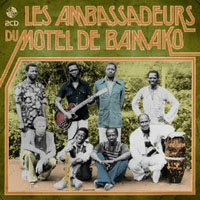
|
LES AMBASSADEURS DU MOTEL DU BAMAKO (Stern's STCD3065-6)
Wittgenstein, I think it was, once said, "The piece of music must be played backwards for the spell to be broken." I don't think he was referring to literally spinning discs backwards looking for signs that "Paul is dead," or whatever, but that you have to change perspective to understand things. If we look at the career of Salif Keita it's good to see it in the context of his early work with the Rail Band and his long stint with Les Ambassadeurs which, in many ways, foreshadowed his solo career once he moved to Paris. The late Ambassadeurs work was very sleek and set the groundwork for the "Paris sheen" that was manifest on Soro, his huge worldwide hit. That album was a magnificent achievement but once other artist started to emulate it, with synth washes and studio effects, we lost a lot of the "realness" of African music and it moved to a musically generalized mush so you couldn't tell if an artist was from Cameroun, Mali, Congo, or had even been there. But Keita subsequently returned to some of the more folkloric sounds (e.g., in his album Folon) that marked his early career and his outstanding collaborations with Kanté Manfila, the guitarist. After his debut with the Rail Band he moved from the station to the motel. The Rail Band was based in the buffet bar of the Bamako railway station hotel, but a rich member of the military junta lured Manfila and Keita away to play at the more upscale motel across town, and thus Les Ambassadeurs du Motel were born (with an equally improbable name as their predecessors and now rivals). And they really became Ambassadeurs once they toured neighboring countries: they did come from Senegal and Guinea as well as Mali, so the diplomatic tag fit. A retrospective look back at Salif and Les Ambassadeurs allows us to see how threads of the traditional music became modernized and set the stage for later innovations. In addition to Kanté Manfila, the founding leader, the big boss lured in the cream of Malian musicians. (N.B. Kanté Manfila, the guitarist, must not be confused with his cousins of the same name. One was a singer with Balla et ses Balladins, known as "Soba," another - "Dabadou" - sang with Keletigui.) Salif was not the only vocalist, in fact he was the junior member. Beidy Sacko sang the Afro-Cuban songs (covers of Celia Cruz and Orquesta Aragon), Moussa Doumbia was the R&B specialist, and Ousmane Dia, formerly of the Star Band de Dakar, sang the Wolof hits. In addition we find, in one band, the great multi-instrumentalist Keletigui Diabaté and guitarists Amadou Bagayoko (later of Amadou & Mariam fame) and Ousmane Kouyaté. The songs, from 1975 to 77, have been compiled from scarce albums released on the SonAfric label in France. In addition to their three LPs they issued half a dozen singles, also collected here (though all but one, "Mana Mana" b/w "Ambassadeur," were gathered on the LPs 50.014; 50.030; 50.031, according to Stefan Werdekker of WorldService). A couple of reviewers have complained that they have been EQ-ed too much (one wrote "the quality of the releases is shameful -- spelling errors galore, cheap production, and a terrible flat sound that some tone-deaf fool has applied AFTER the recordings were made. Those Syliphone re-issues are a case in point..."), but a bigger issue is the bonus material. Two tracks have been added from Radio Mali broadcast tapes. The question the experts are posing is, Is it even Les Ambassadeurs? They could be by Keletigui, Bembeya Jazz or some other Guinean band. Nevertheless, for those who don't have the original vinyl, this is a superb set: the first disc is all Salif singing; but the second disc, which also features the other vocalists, really catches fire, opening with a ten minute workout in griot mode, before we jump into one of their R&B rave-ups, "M'bouran Moussou." The organ, played by Idrissa Soumaoro, is more prominent on the second disc, and we also get some trumpet-led descargas and the Latin soul of Ousmane Dia. His "Fatema," especially, is sparking. The flute and violin (uncredited) have been studying Afro-Charanga and stand alongside contemporaries like Nestor Torres, José Fajardo, Eddie Palmieri, Alfredo de la Fé and others. In a military purge in February 1978 the Motel's patron was imprisoned so the patronage vanished, and the majority of the band moved to Abidjan and regrouped as Les Ambassadeurs Internationaux. But here we have the fruit of their two years performing under the thatched cabanas on the banks of the Niger. |
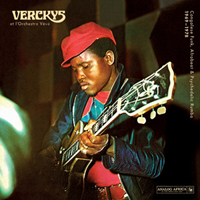
|
VERCKYS et l'Orchestre Vévé
Congolese Funk, Afrobeat & Psychedelic Rumba 1969-1978 (Analog Africa AA17 2014)
When you pull out all the stops on a church organ you get an almighty noise guaranteed to raise the roof. When Samy of Analog Africa does it, you get a killer album of rare tracks from one of the most rumbustious acts to come out of the Congo in the rip-roaring 70s. Georges Kiamuangana "Verckys" was a saxophonist with OK Jazz from 1963 but didn't always see eye-to-eye with his boss and finally, in 1969, broke away to create his own band, his own studio, and even his own label (in 1970) from where he threw hit after hit onto turntables across Africa, from Lagos to Nairobi. Though the sax was his main instrument (his nickname came from mishearing King "Kurtis" as "Verckys") he was soon to jettison the horns and feature the stripped-down acts of the generation Langa Langa which replaced the older dance bands of Franco and Rochereau. Verckys had monster smashes with his own band, Orch Vévé, as well as the numerous bands he nurtured like Orchestres Bella Bella, Kiam, Les Kamale, Empire Bakuba, Lipua Lipua, Les Grands Maquisards, Zaiko Langa Langa and Stukas. His first three albums were put out by Ngoma before he started his own state-of-the-art studio, to which he added a record-pressing plant. He then signed Rochereau and recorded four very successful albums, including Maze. In 1977-8 Sonafric issued a nine volume series of Grands Succès, Direction Verckys. Because of the great passion for Congolese rumba and cavacha in East Africa, Verckys went on tour to Uganda and Kenya. He struck a deal to reissue albums in Nairobi and recorded the smoking "Nitarudia" with Orch Vévé Star (So far, I've found a dozen albums released in Nairobi in those golden years 1983-5.) The audiences went wild. Any talented bass player was compared to Vévé's Shaba Kahamba. Some Vévé musicians decided to stay behind and formed Orchestre Bana Ngenge. The Vévé sound was so pervasive (and portable) that many Congolese acts moved East and played the stripped-down music with sax and multiple lead guitars. Other aspects of Verckys' career and his productions appeared periodically on Sonodisc in Paris. In the 1990s Sonodisc issued a couple of greatest hits CDs and RetroAfrica leaned heavily on them for its reissue called Vintage Verckys. Since I maintain the collaborative Vévé discography (elsewhere on this site) I can quickly pinpoint the source of these tunes, and it is really startling. Samy has had a fresh look, and only taken tracks from a couple of known albums: the rest are 45s and quite a few of them - six - obscure B-sides. Needless to say he has come up with the goods: every track on here is a revelation. Yes, I think the entire output of Verckys should be reissued & this first step in that direction makes a good case for that.
The CD kicks off with a sax-led funk track (with pidgin English lyrics), "Bassala hot," which was featured on Grands Succès vol 2 and reflects particularly the Nigerian passion for James Brown. But then we kick into the cavacha sound that became the high watermark in East Africa, with wild dueling guitars, snapping snare drums and sweet vocals harmonies. I am guessing Roxy Tshimpika is on lead guitar, but there was no info on individual tracks in my digital copy. I would love to know who is singing on here, and even the sax which I think is Moro Beya Maduma. I heard a shout-out to Aladji who is the rhythm, or mi-solo guitarist with the alluring name Aladji Baba. "Cheka sana" returns to the funk, this time with twin saxes (Matalanza or Verckys himself with Moro Beya?). "Oui Verckys" follows: this time organ-led and highly reminiscent of "Mother Popcorn" by James Brown. Enough with the funk, back to the mellow rumba with "Nakobala yo Denise," a love-song with lyrical sax and a kick-around seben at the midpoint of the 4-minute nugget. Organ returns with jazzy sax and a more psychedelic groove for "Sex Vévé," which brings to mind "Sex Madjesi" and Sosoliso, the splinter group from Verckys headed by his original trio of singers. This shows off his jazz sax while the guitars churn out blues chords. Back to the cavacha sound next (not sure this sequencing works, it jumps about a lot) for the lovely "Sisa Motema," then back to Famous Flames for the B-side of "Cheka sana," called "Talali Talala," another funk instrumental. According to Ben Redjeb three of the tracks were recorded in Nairobi. I don't know them and don't see any sign of them on kentanzavinyl either, so the originals must be pretty obscure. We strike a happy medium with "Zonga vonvon," which I would classify as a "rave-up," a speedy romp with shrill vocals and shouted chorus as well as some honking from the leader. The lovely high tenor voice on echo, launched by Tabu Ley and carried on by Nyboma was also a big thing in East Africa, with artists like Lovy Longomba and Nguashi Ntimbo. Here we get a taste of it on "Nakomi Paralise" (which may or may not be a typo for "Paradise"); singers unidentified. Actually my unease at the arrangement may be that we start with two long ten-minute tracks then have a real smorgasbord of seven varied styles until we get back into a groove with the 6 minutes and 41 seconds of extended bliss that is this guitar- and horn-driven workout. The shortest track is a charanga-style blowout called "Matinda comono" in pidgin Spanish. Then there are three bonus tracks (which I guess are not on the vinyl): "Nitarudia" is outstanding with sax and piano (a rarity) and a tight arrangement. I wish we had personnel listings on these cuts. Still it is a monumental set and bodes well for future reissues, from Analog Africa, with their faultless track record, and also for more from Mr Dynamite: Verckys.
|
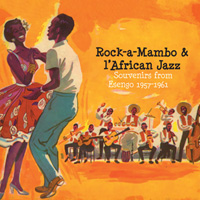
|
ROCK-A-MAMBO & L'AFRICAN JAZZ
SOUVENIRS FROM ESENGO 1957-61 (Planet Ilunga 2XLP)
The legendary Congolese studio band known as Orchestre Rock-a-Mambo (though they played rumbas, cha chas and merengues, I don't know if they ever recorded a mambo) finally gets a reissue. Gary Stewart explains the origin of the name in his book Rumba on the River: it is a pun on the Ki-Kongo word rocamambu, one who looks for trouble. It comes from an African folk tale about a prodigal son who is considered a good-for-nothing, leaves home and works hard to return a success. For his second vinyl reissue, Bart of Planet Ilunga has found some truly rare Rock-a-Mambo and African Jazz sides that were issued on 78 rpm shellac discs in the Congo in the years before Independence (and then reissued, some of them, on Pathé Marconi, like African Memories of 1976 or Columbia EPs, such as Congo Latino, in the 60s and 70s). This music was inspired by early Cuban recordings reintroduced into Africa. When the Africans heard it they recognized the essential truth of it and took it to heart, even adapting simplified or nonsense Spanish lyrics ("Ay yi yi mi nina"). They then took the metronomic clave beat of Cuba and added latitude to it. Over the years I've made my own compilations of this wonderful sound. John Storm Roberts sent me a cassette of some 78s he owned and that got me going on a quest to find more Rock-a-Mambo. You may see my own webpage about them here. Though it's essentially Cuban you'll hear "Lon-dee lon-dee li" from a 50s New Orleans pop song (in "Babalou"), even a quote from "Theme from a Summer Place" (Not on this set but quoted by OK Jazz on "Ah, bolingo pasi" and Les Bantous on "Yaka na Ekala"). [Aside: the famous "lum dee lum dee laa" lyric comes from "Mickey's Monkey" by Smokey Robinson & the Miracles in 1963 -- later than this Rock-a-Mambo version. So who did the original?] There are 14 tracks each from the two featured bands, though the players often broke into smaller groups or brought in a different singer for a session. Nino Malapet and Jean Serge Essous, both horn players, were the mainstays of Rock-a-Mambo, and both left later to form Les Bantous de la Capitale. The clarinet and alto sax entwined with jazz guitar are irresistible. The moody "Baila," the first hit of the group, introduced them with the lyrics, "El nuevo ritmo cha cha cha, la musica bella Mexicana, Santa Maria, ... ritmo Rock-a-mambo, musica Africana, ritmo Mexicano, saca la cabeza"(!) The horns are the lead instrument instead of a singer, there is a chorus, the piano part has been transposed to electric guitars which skitter about. Congas, electric bass and maracas fill out the pulsing beat. This and three other tracks here were included on the rare African Retro vol 5, a great Rock-a-Mambo collection from Pathé in 1977. "Oyé Jacquy," another hit, tells you to to "Oïga Rock-a-mambo, Kalle, oïga cha cha!" "Oye Jacquy" is one of my all-time favorites with its spare pulsing acoustic bass and simple congas and maraca percussion, around which the guitar dances, with the horns punctuating it briefly. Various other persons are enjoined to listen. That's it: "listen to this," over a throbbing seductive beat. This is the cleanest I've heard these recordings and also the first time I've heard several of them.
"Baila (Dance)," was a cha cha written by Essous and members of African Jazz were brought in on the session. So the first recordings featured the voices of Joseph Kabaselle and Lando Rossignol, later joined by Joseph "Mujos" Mulamba; Nino Malapet played sax alongside Essous' distinctive & unique clarinet, and African Jazz's guitarists Nico Kassanda and Tino Baroza played with Roitelet on bass. These members all get name-checked in the songs. The formation of Rock-a-Mambo seems to have been for fun and to indulge a shared passion for Latin music. They wrote Spanish lyrics without much effort ("Yo me muero, ay, yo te quiero" -- yes, really), but every groove exudes joie-de-vivre, or esengo. Eugène Ngoyi ("Gogène") and Papa Noel also played guitar for the band as needed, and the pool of musicians included veteran Honoré Liengo on acoustic bass and "Saturnin" Pandi on congas, as well as Léon Nzambe ("Sathan"), Alphonse Epayo (guitar), Lucie Eyenga (vox), and Maproco (sax). Their first recordings included "Toca mi" (included here), and "Ya Mouele" (which appears to be lost, but may be the origin of the Joe Arroyo song). The young fans thought of them as a continuation of Negro-Jazz, a group that had specialized in popular Cuban dance rhythms. First time reissues here include "Lily Germaine" b/w "Pesa ngai..." (Esengo 4A/B), "Toca mi" (Esengo 11B), "Siempre mi" b/w "Rosignol Cantador" (Esengo 12A/B) and "Mioto ya likolo" (Esengo 131A).
The second disc focuses on African Jazz. I was a little dismissive of Bart's first release of African Jazz on Planet Ilunga since it had all been available on Sonodisc CDs, but for those who prefer vinyl it was a good collection and this time around he has included obscurities that make this worth delving into. Two of the tracks were on Grand Kalle vol 5, which I found on the excellent Worldservice website. While others may be familiar it's great to have a fresh take on this timeless music. I should say they are familiar to me, but may not be as familiar to you! Again we kick off with a namecheck, in the classic "Chauffez African Jazz," and get a nice dose of Docteur Nico's early work on "Leo se Leo" (a real rarity) and "his "Tembe nie" (previously on African Memories). The fourth side includes four cuts by African Rock, yet another formation of some of the same artists on Esengo, including singers Charles Kibongue and Lucie Eyenga.
There are only 500 sets of the vinyl double album. If there's enough demand a digital or CD release may come along. Curiously I looked up Rock-a-mambo on EBay and there was a copy of the Congo Latino EP (which has two songs by Rock-a-Mambo and two by Negro Band) for the same price as Planet Ilunga's double LP. But there's no guarantee that when an EBay seller says record is VG++ that it is anything better than thrashed! So grab this while you can.
|
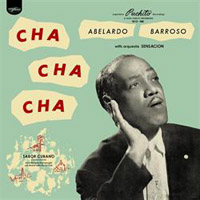
|
ABELARDO BARROSO
CHA CHA CHA (World Circuit)
From the label that brought you Buena Vista Social Club, it says optimistically on the front of this nostalgic reissue. Since he was born over a century ago, it's unlikely Abelardo or remnants of his band will be touring again to promote this. Fans of Cuban son undoubtedly have one of his "best of" compilations (e.g., that on Edenways 1997), or Bruca Maniguá by Abelardo Barroso con la Orquesta Sensación from 1961. His history is well-documented in the annals of Cuban music. One of the first son groups was Sexteto Habanero and in 1925 Abelardo joined them ... as driver! But the following year he joined first Sexteto Boloña of Alfredo Boloña as sonero, then Ignacio Piñeiro's Septeto Nacional, and traveled to New York to record for Columbia Records. Columbia insisted on having a trumpet and Barroso was able to vocalize in concert with trumpeter Lázzaro Herrero who had expanded the sextet into a septet. In the 30s he was known as "Caruso" when he sang with Cachao's brother Orestes Lopez and was with them as they transformed the danzón into the charanga. In the mid-30s he launched a solo career with his wonderful and timeless "La Huerfanito (the Orphan)." In the mid-50s, strapped for cash, he approached orquesta Sensación and suggested they re-record his 1939 classic, "En Guantánamo." Older members of the audience ate it up and he made new fans. This monster smash was followed by other classics including "El Guajiro de Cunagua," "Tiene Sabor," "El Panquellero,"and "La Hija de Juan Simon," all of which are collected here. Barroso who has a throaty tone, suggesting a glass or two of rum has lubricated his throat, never used a microphone and ultimately paid the price: he had to have surgery on his vocal chords in 1967 which ended his career. Also the Cuban revolution ended his triumphant overseas tours to Miami and New York. Even the legendary Beny Moré looked up to him as a teacher and, as Machito laid claim to the mambo, Barroso made the cha cha cha his own domain. It is wonderful that World Circuit has returned to Cuba and if this flies they may delve further into the vaults. If you think the cha cha cha is something staid your swinging uncles and aunties did at cocktail parties, check out the wild percussion (guiro, timbales and congas), tight arrangements with piano, violins and flute, and especially the slurry good-time vocals of señor Barroso, the Cuban Caruso. |
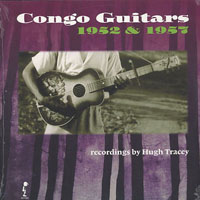
|
CONGO GUITARS 1952 & 1957
RECORDINGS BY HUGH TRACEY (Sharp Wood Productions SWP045)
I saw this on vinyl at a local record store and noticed it was mostly compiled from 3 Sharp Wood CDs so decided to pass on it, but I thought I should write it up anyway. I was the last person to give up vinyl (though a lot of the music I love never came out on CD), but I have finally converted all my African LPs to digital files, and now I discover I was right all along: vinyl is better. Hugh Tracey first encountered the Katanga sound -- a rich guitar sound based on traditional likembe thumb-piano riffs -- performed by the Luba people in the mining towns of Southeastern Congo in the 1950s. It had a worldwide impact at the time and influenced people as diverse as Pete Seeger and the young Franco. The album kicks off with "Masengu" by Patrice Ilunga and Victor Misomba. There are two guitars and bottle percussion and the vocals are in a mix of Swahili, Kiluba and Kanyok, a typical mining camp mix of dialects and languages: the singer is broke and depressed, all the women are back home and he just wants to get stoned! Another bluesy song from the mining camps, "Mangaay," adds basket rattles as the singers drunkenly boast about killing their neighbors. Again we get a dancing interplay of two guitars, courtesy of Chiband and Kazeng. Patrice Ilunga and Victor Misomba return with "Mama Josefina," which is the lead cut on the superb Origins of Guitar Music CD (Sharp Wood SWP017). A third track by the duo, "Antoinette wa Kolwezi," has not been previously reissued on Sharp Wood (but can be found on the Kaleidophone LP that sounds like a lop-sided score, Musical Instruments 6. Guitars 1, issued in Washington DC in 1972. Another previously un-reissued track, "Mudima zenzele," by Anatole Kaseba can be heard here, on the website of the South African Music Archive Project (but taken from a scratched 78). Other tracks are drawn from Origins of Guitar Music, as well as The Very Best of Hugh Tracey (SWP034), which to my delight grouped the 1952 Jean Bosco Mwenda recordings at the end. Bosco was busking under the town clock in Jadotville when Tracey encountered him one Sunday morning in February 1952 and captured his act on tape. I would venture that this recording is as important to African music as the Robert Johnson sessions to American music. Furthermore the set was almost lost, but had been preserved on a radio transcription of one of Tracey's broadcasts. Two of the songs were included on the African Music Society's LP Best Music for 1952, which I have on 10" LP from London records; Guitars of Africa (Vol 5 in London's series) has the original letterpress leaflet laid in, including a photo of Bosco which Tracey must have taken on the spot. The biggest star in Stanleyville at the time was Charles Ombiza, leader of Oroclos, whose guitar style had come through Angola and was called rumba (it is strummed rather than picked). He too sang about the plight of the poor workers. If you don't have Guitars of Africa, Origins of Guitar Music or The Very Best of Hugh Tracey and still have a turntable, you may want this distillation of some of the best guitar music every recorded. And if you decide to spring for the shipping from Sharp Wood, check out their other new LP Congo Traditional (SWP046), which is drawn from Hugh Tracey's bush recordings in the Belgian Congo on another musical safari. There's drums, likembes and flutes, and I've said it before: you can hear Bach fugues in the sublime Nande flute tunes which end this set. |
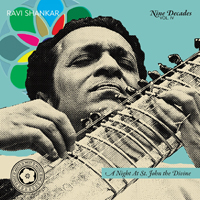
|
RAVI SHANKAR
A NIGHT AT SAINT JOHN THE DIVINE (East Meets West EMWM1013)
Now that Morgan Freeman has replaced Charlton Heston as the voice of God, it's time to assess his abilities against another box-office giant who is regularly called on to voice the divinity: Amitabh Bachchan. But it doesn't take too many snippets to figure out who'd win a divinity throwdown or God-off. When it comes to Vox Dei or Godvoice, Amitabh wins handily. Indeed, he is already a minor deity in the Land of 10,000 Gods and you know no one does deep spirituality like the Hindus. Christianity is bound up in guilt and pettiness. Its main assets are the Jacobean translation of the Bible and its architecture. Now imagine we blend the two religions, and put Hindu spirituality in a reverend, resonant and reverberant Christian space: the Cathedral of St John the Divine in New York. For volume four of the Nine Decades series, dedicated to issuing the best recordings of Ravi Shankar in an orderly fashion, East Meets West has opted for one night that Ravi spent in church on a bill with a host of other acts from dusk to dawn. The first piece is an afternoon raga. As Ravi says, "we are worshipping the divine sound in the house of God." The musician and the listener become one, he tells us, as eyes closed, we nod in consent. Then, on cue, he explains the metre of the next piece, four-four-one-half-one-half. No one laughs; no one goes, Huhn? Apparently, by then, the sun was rising (Ravi is the Sanskrit word for "sun") and as the light poured through the stained glass windows and the somnolent audience stirred in the pews, Ravi ripped into a sunrise raga, "Vachaspati," with his faithful accompanist Alla Rakha, one of the few musicians who could keep up with the master. There is an odd break-tempo moment about every nine beats in this piece: tapping it out on your knee is futile but you sort of sense it coming. Nevertheless there is a fluidity and grace to this work. It's nice to hear it in the comfort of your home and not in a coccyx-crucifying pew, but perhaps the mortification of the flesh, the long night ending and the holy dust suspended in the stained-glass-filtered light would add something. Who knows? you weren't there. Me neither. But, as Baba Ram Dass might say, you can be there now.
|
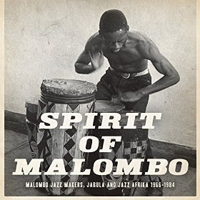
| SPIRIT OF MALOMBO
MALOMBO JAZZ MAKERS, JABULA AND JAZZ AFRICA 1966-84 (strut)
Long-time fans of African Jazz will recognize the name Malombo and associate it with Philip Tabane. In the 80s Günter Gretz launched one of the great series of recordings: his aim was to find a characteristic album of each style of African music or, if one didn't exist, to create it as a compilation. He brought us Sam Mangwana jamming with members of OK Jazz, Etoile de Dakar, Balla et ses Balladins, Orchestre Baobab, Sweet Talks and many other essential recordings that delighted and informed us. Each of these became treasures that followers of his Popular African Music label prized above most others. For his 13th release he compiled Man Phily from 4 albums and a cassette recorded by Philip Tabane and his Malombo Jazzmen. American Jazz only took root in South Africa; the influences in other parts of the continent were Cuban music and later R&B and pop. And South Africa had rich indigenous traditions. Mbube originated in church choral music (with gospel and blues elements) as exemplified by Ladysmith Black Mambazo; Kwela (pennywhistle) music was played on the street with home-made instruments; a musical style that mixed traditional and modern forms (under apartheid) was Mbaqanga which had a huge international impact with the fabulous tours of Mahlathini and Mahotella Queens. Jazz, in its more stately way, issued forth in wonderful recordings by Dollar Brand (Abdullah Ibrahim). Tabane formed his first group in 1961 with himself singing and playing guitar, backed by Julian Bahula on the hollowed log drums that gave the group its name. Oupa Monareng replaced Bahula on malombo drums and then other percussion instruments, in addition to bass and flute, were added. In 1988 an eponymous album was reissued by Kijima Records in London.
This new release on Strut follows the other thread of the story. The original Malombo drummer, Julian Bahula, left Tabane with flautist Abbey Cindi after one year and created the Malombo Jazz Makers. Though they won festivals and recorded albums they received only small change from Gallo records for their efforts. Both bands with the Malombo name brought Hilda Tloubatla of Mahotella Queens into the studio to sing on their records (featured here on "Hleziphi," which sounds like a Zulu ballad, and the uptempo "Jikeleza"). The political significance of jazz with African drums was not lost on the audience as, of course, overt anti-apartheid lyrics would mean imprisonment. The skin-covered drums were made from hollowed-out baobab roots and Bahula would hide ANC documents inside them when they toured! The heat was on though and eventually Bahula fled to London (touring with a white group) & stayed there until the end of apartheid. Fortunately other expatriates including saxophonist Dudu Pukwana and a big group of ANC activists were also there to help promote the band and the cause. It's a mostly mellow album, better when Cindi plays sax rather than flute, to my ears. Few of the songs rise to the abstract genius of Tabane's "Hi Congo," "Ki Kgale," or "Phamba Madiba," but the good news is Strut are planning a sequel featuring the other branch of Malombo.
|
[All writing on this website is Copyright 2014-5 by Alastair M Johnston]
HOME
|






































